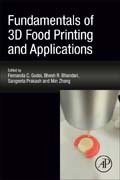
Fundamentals of 3D Food Printing and Applications
Godoi, Fernanda C.
Bhandari, Bhesh R.
Prakash, Sangeeta
Zhang, Fumin
Fundamentals of 3D Food Printing and Applications provides an update on this emerging technology that can not only create complex edible shapes, but also enable the alteration of food texture and nutritional content required by specific diets. This book discusses 3D-food printing technologies and their working mechanisms within a broad spectrum of application areas, including, but not limited to, the development of soft foods and confectionary designs. It provides a unique and contemporary guide to help correlate supply materials (edible inks) and the technologies (e.g., extrusion and laser-based) used during the construction of computer-aided 3D shapes. Users will find a great reference that will help food engineers and research leaders in food science understand the characteristics of 3D food printing technologies and edible inks. Details existing 3D food printing techniques, with an in-depth discussion on the mechanisms of formation of self-supporting layersIncludes the effects of flow behavior and viscoelastic properties of inksExplains the printing behavior of a broad range of edible inks from various sources, such as vegetal, dairy, red-meat, poultry, seafood and unicellular green algaePresent strategies to enhance printability, such as the incorporation of hydrocolloids and lubricant enhancers INDICE: 1. Introduction to 3D food printing Part I: 3D food printing technologies 2. Extrusion-based 3D food printing 3. Laser-based 3D food printing 4. Ink-jet deposition of binder solutions onto powder bed Part II: Edible inks - Applications 5. Vegetal sourced edible inks 6. Dairy sourced edible inks 7. Red meat sourced edible inks 8. Poultry sourced edible inks 9. Seafood sourced edible inks 10. Unicellular green algae, nostoc or fungi sourced edible inks 11. Confectionery products 12. Cereal-based products 13. Confectionary products 14. Edible soft gels Part III: Properties of printability enhancers 15. Hydrocolloids (carbohydrates and proteins) as additive on 3D food printing 16. Lubricant enhancers 17. Crosslinking agents (chemical, physical and enzymatic crosslinking) Part IV: Industrial perspective and future development 18. 3D food printing market segmentation 19. 4D printing technology
- ISBN: 978-0-12-814564-7
- Editorial: Academic Press
- Encuadernacion: Rústica
- Páginas: 728
- Fecha Publicación: 15/11/2018
- Nº Volúmenes: 1
- Idioma: Inglés
